Résumés Part 1: Goals & Types
After reading these notes—at the least—you should
- know what a resume is; know what a resume is supposed to do
- understand the value of keeping a “master resume”
- know the difference between the three different types of traditional (print) resumes—chronological, skills, and combination
- have an idea which of the three traditional resume types you should use (either chronological, skills, or combination
As part of your Job Search Portfolio project, you must write a Traditional Résumé for the job listing you selected to use as the basis for this project. This means that based on you and your job-search-related history*, you will have to make a conscious decision about what type of traditional resume to write—a chronological resume, a skills (or functional) resume, or a combination (hybrid/mixed) resume.
Because most undergraduate students don’t have a lot of work history within their career field, or have lots of unrelated and/or short term retail or service employment, most undergraduate students should consider a skills or mixed resume.
As you think ahead to writing your resume, keep in mind that you MAY NOT use a resume template—MS Word or other templates WILL NOT be accepted. Instead, you must use good H.A.T.S. document design and design your resume yourself.
Most of you have and old resume somewhere on your computer. Forget about it. Start fresh. Seriously.
That old resume you have was probably written to get a retail job, or as part of a school assignment (without a particular position in mind), or written by following “career advice” from a pamphlet or resource. You probably wrote that old resume with a template—you probably opened the template and filled in the blanks.
Don’t use that old resume. Seriously. Don’t even open it. It will not help you here.
In fact, attempting to use that old resume will probably hurt you because you’ll spend your time trying to fix something that wasn’t good in the first place.
Don’t do it. Every semester, a couple of students don’t heed my advice—they pull up their old resumes from high school or freshman year and attempt to update it for this assignment. At best, those students struggle. At worst, those students fail this project. Opening your old resume and fixing it up a little is a BAD IDEA. I promise.
I don’t like old documents or templates because they aren’t rhetorical. Instead, what I’m asking for the resume portion of your JSP asks you to think rhetorically, to think broadly about your experiences, and to do your best to make show how your experiences make you a good candidate for the position described in your job ad.
Please take my advice. Please forget about that old resume (at least for now).
What Is a Resume?
Yes, résumé (a noun meaning a document that serves as a concise summary of a person’s education, work history, and accomplishments) is spelled with an accent aigu (accute accent) on each ‘e.’
Please excuse the incorrect accents through the remainder of this document (and others).
A resume is a document that summarizes your education, skills, talents, employment history, and experiences in a clear and concise format for potential employers. The resume serves three distinct, overarching purposes that define its format, design, and presentation:
- To represent your professional information in writing
- To demonstrate the relationship between your professional information and the problem or challenge the potential employer hopes to solve or address, often represented in the form of a job description or duties
- To get you an interview by clearly demonstrating you meet the minimum qualifications and have the professional background help the organization meet its goals
![]()
The Functions and Goals of a Resume
To break down the three purposes above further, a well-written resume can do seven specific things for you and your job search:
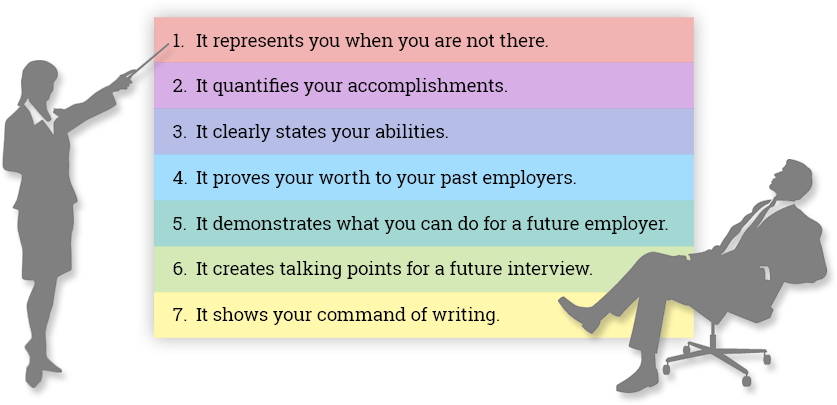
It Represents You When You Are Not There
Your resume can be uploaded to global job boards like Monster, CareerBuilder, and others in a few minutes. It can be sent to a company’s online database with a push of a button. It can then be shared with dozens of recruiters and hiring managers without you even knowing about it. In fact, it’s a lot easier to get your resume in front of a recruiter than it is to have a physical presence in their office; therefore, make certain it’s a well-written, well-positioned document that makes an exceptional first impression.
It Quantifies Your Accomplishments
The best resumes quantify results and accomplishments clearly and easily. Here are some examples:
- If you reduced errors by 35%, if you increased profits by 55%, and if 75% of your customers are repeat customers, include this information clearly, succinctly, and proudly.
- If you have been a student teacher with thirty-five students in a classroom and student grades improved by 25%, include that as well.
- If you have worked as an administrative assistant in a dentist’s office and you are part of a marketing team that has increased new patient accounts by 10% last quarter, include that!
- If you worked in the school library and the number of lost books has declined by 50%, or if you provide guidance to approximately fifty students per day, that information should be in your résumé.
Quantifying your accomplishments gives your resume readers the specific information they need to know about your abilities and to be intrigued by what you can do for them.
As a student, perhaps you don’t yet have the experience that would allow you to quantify work accomplishments so easily. But think broadly about what you’ve done in your classes, your volunteer experience, and in student organizations. If you increased the membership of the FAU Student Film club by 10%, be sure to mention it! If you increased funds for your chapter of Phi Sigma Pi National Honor Fraternity while you were at Palm Beach State, put that on your resume! Think about all of your accomplishments, big ones and “small” ones — all accomplishments and results can speak to your ability to do great things in your career.
Even if you can’t quantify results, you should still find a way to speak to results on your resume. Perhaps you ensured excellent customer service at your retail job. Perhaps you maintained food quality and customer satisfaction during their dining experiences at Applebee’s. All of that speaks to your commitment to your current postion/s and suggest you’d show similar commitment in your future career.
It Clearly States Your Abilities
Focus on the results of your actions. Being results oriented helps resume readers understand your abilities. What exactly do you do, or what have you done in the past? Your resume should answer this question very quickly. For example, if you have been responsible for opening and closing a retail store on a daily basis and for managing the register that took in approximately $1,000 worth of merchandise a day, state that clearly and concisely. If you have written three to four sports articles for your school paper every month for the past three years, include that as well. The more you quantify your accomplishments, the more your abilities will be understood.
It Shows Your Command of the Written Word
You don’t have to be an English major to make sure that your resume is well-written. If your school has a career services department that offers resume workshops, be sure to participate in them. Ask an older sibling who is in the workplace to review your resume before it goes into cyberspace or to a future employer. Other options include asking a teacher, professor, or perhaps someone with whom you worked with or for in the past to review your resume. Or you could take a Professional Writing class, work hard on your Job Search Portfolio, and get feedback that will help improve your resume.
Whatever the case, it is your responsibility to have a well-written resume. Remember that if you have just one misspelled word, your resume could easily be dismissed, along with your candidacy. It’s critical that your resume be accurate and well written.
It Creates Talking Points for Your Future Interviews
Clearly listing your accomplishments and quantifying those accomplishments can create talking points for your future interviews. For example, perhaps your bullet point is the following:
- Responsible for the intake and outtake of approximately 1,000 books daily, ensuring that all library users are logged into the new electronic database, which has decreased the number of lost books by 80 percent in the past year.
Many individuals have to think about the results of their work. Including this detailed information in your resume actually allows you to easily talk about the value you’ve brought to previous employers. During an interview, with the preceding example in mind, you can easily talk about how you use technology to improve processes. You can discuss the team environment of the library staff and how you are all working toward decreasing the number of lost books. It shows that you have positively affected the bottom line by helping libraries hold onto books versus losing them, which results in unnecessary fees to library users.
It Proves Your Worth to Your Past Employers
Whenever including bullet points about past work, always tie your efforts to the bottom line — to the main purpose of your organization — things like profits, membership, engagement, satisfaction, outreach, etc.
Information relating to a organization’s purpose is exactly what employers want to read. Highlighting results like these increases your chances of having your resume noticed.
It Demonstrates What You Can Do for Your Future Employer
Unlike financial investments, past performance is an indicator of future success, so include and quantify your past performance, and future employers will be inclined to believe you can do the same for them. They will believe it, but you have to continue supporting that belief with your exceptional networking and interviewing skills. Remember, however, that your resume is introductory in nature. You want to get their attention and initiate their interest so you can get your foot in the door.
Remember, a resume won’t get you a job. Your resume gets you an interview, and that interview could get you a job.
![]()
Keeping a Master Resume
A master resume is NOT something you will send out as part of your job search. Instead, it’s an-everything-on-it, ugly, unformatted list you can draw from in order to create new, real resumes tailored to specific job opportunities. It’s for you — not for anyone else’s eyes — to keep track of everything you’ve done.
Your master resume should have ANYTHING and EVERYTHING on it—experiences and activities as far back as the beginning of high school, as diverse as unpaid experience, college courses and descriptions, projects and papers, “small” volunteer work, clubs, organizations, leadership positions… everything and anything else you can think of.
For everything you list on your master resume, make a note about your dates of employment; official and unofficial projects you completed, duties you carried out, responsibilities you had, skills you used; locations, addresses, supervisors, and coworkers, etc. It need not be pretty—it just needs to be detailed and inclusive.
When you create a “real” resume you will send out to potential employers, you can draw ideas and elements from your master resume that are appropriate for the specific job you want. Your master resume will have everything in one long file—dates you may have otherwise forgotten, experiences you hadn’t thought of, and skills that may transfer to the position you want.
As you proceed through your career, you should add to your master resume at least once a year—perhaps more often as things happen. When you change careers, apply for new jobs, or seek different experiences and positions, you can look back at your mega-master resume for those items in your past that you can use to prove your qualifications for new opportunities.
On my computer, I have a master resume file that’s a gigantic list of stuff I’ve done, positions I’ve held, classes I’ve taken, projects and papers I’ve written, volunteer work, awards, certifications, names of past references and contact information, and everything else I can think of. Whenever I do something new, I pull up my ugly Word file and add to it. I’ve been teaching at the university level for over 15 years, but my master resume file goes all the way back to high school.
When it’s time to apply for a new position, a new scholarship or fellowship, pull up your ugly master resume file and pull items out that you think are important for the thing you’re applying for. If you’re applying for a Women in Business scholarship, you probably won’t include a line about being the treasurer of your high school’s flag football club. But, if you ever apply for the position of staff accountant for the Miami Dolphins, that flag football club treasurer position might show that you have the experience the employer is looking for.
![]()
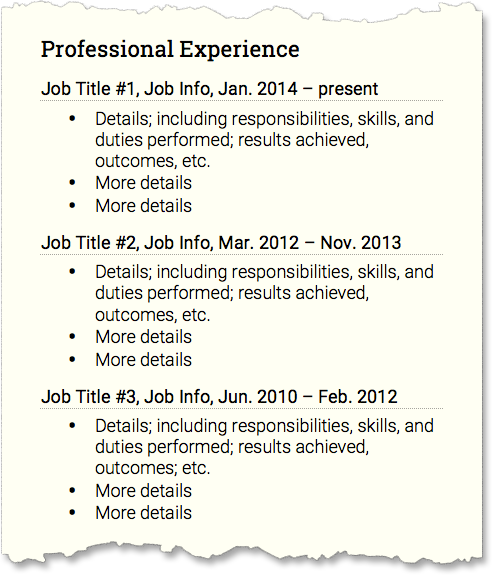
Types of Traditional (Print) Resumes
When you have a position in mind and need to create a new resume to appeal to that particular position and a particular audience, you should decide what kind of resume you need.
Chronological Resume:
Chronological resumes are traditional, formatted (see “H.A.T.S.”), print resumes that show your experience over time. Generally, you list items in reverse chronological order from the most recent. Because chronological resumes show experience in reverse chronological order, they demonstrate steady progression within a career and/or toward a position.
According to Chronological Resumes at Purdue’s OWL:
This style of organization is very conservative, and it is most useful for people who have work experience in positions which are closely related to their desired employment. This style is also most suited to people who have not had long periods of unemployment time between jobs. This format starts with the present, or most recent, job and progresses back in time.
|
when to use a
Chronological Resume |
PROS
|
CONS
|
|
|
|
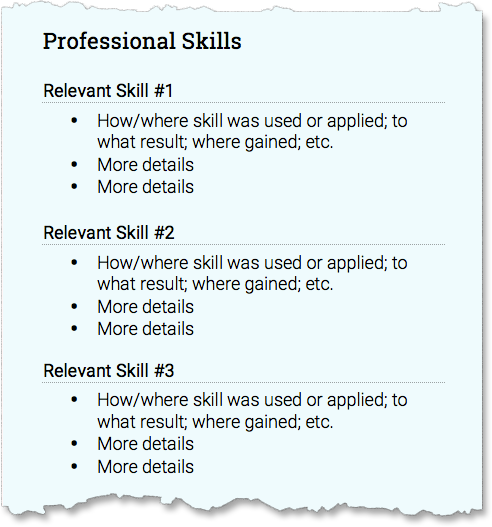
Skills (Functional) Resume:
A skills resume is a traditional, formatted, (see “H.A.T.S.”) print resume that emphasizes skills you’ve used or developed by organizing the resume according to skills or abilities.
According to Skills Resumes at Purdue’s OWL:
The skills style is well suited to students who have gained valuable experience through a number of unrelated jobs and courses. This format is also appropriate for people who are making a significant change in careers. It emphasizes what you can do, not where you have worked. Applicable skills can be established through any activities that you feel will demonstrate your qualifications: courses, work, volunteer activities, personal life, and so forth.
For example, if you talked to customers as you waited on them at McDonald’s, investigated shipper’s presentations in a psychology course, you have demonstrated communications skills. However, try to match your skills to the position you are applying for. If you are applying for a Customer Service Representative position, you might list the McDonald’s and the moving company activities under a heading called Customer Service Skills.
|
when to use a
Skills Resume |
PROS
|
CONS
|
|
|
|
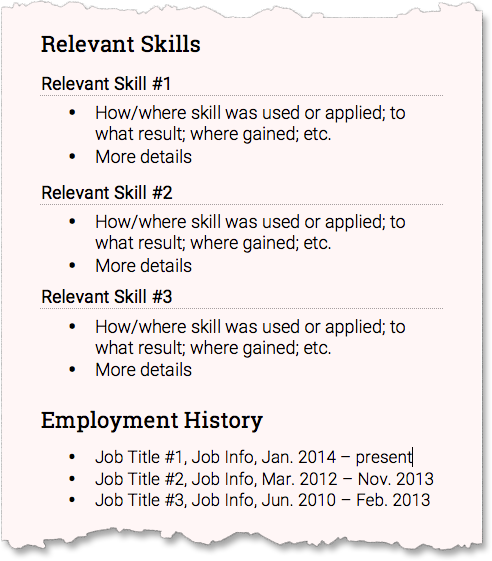
Combination (Hybrid/Mixed) Resume
A combination resume lists your skills and experience first, then employment history and education. It highlights the skills you have that are relevant to the job and provides a reverse chronological work history.
Use a Combination Resume when
- You want to highlight your transferable skills from numerous jobs or volunteer work.
- Your skills are your greatest strength.
- Your work experience differs from your desired career path.
- Most of your work had been contract, freelance, temporary, or unpaid (such as volunteer work, participation in student organizations, clubs, social groups, churches, etc.).
![]()
Other Types of Resumes
Scannable Resume
A scannable résumé generally refers to a resume that is scanned into a computer using an optical character recognition (OCR) application. OCR, or optical character recognition, applications turn scanned or digital images into searchable text. After a resume is scanned using OCR, it is turned into a searchable text file that employers can use to find ideal applicants by searching for keywords contained within the file/s.
For more on scannable resumes (including guidelines for formatting, including keywords, and optimizing with language shifts), please see the ENC 3213 Scannable Resume Notes linked at the right and check out additional online resources such as “Scannable Resumes” from the Purdue Online Writing Lab (OWL).
Electronic Resumes
Inline Resume: An inline resume is plain text, copied and pasted into the body of an email. Preparation and sending of an inline resume is often more complicated than simply copying and pasting your resume text from a word processing application. Often, the conversation from rich text or formatted text to plain text creates strange line breaks, extra spaces, and unrecognized characters, or perhaps worse, email clients will attempt to recreate formatting in html.
To be absolutely sure your inline resume is clear and readable, paste as plain text (with no formatting), and keep styles such as bold, italic, and underline to an absolute minimum. Instead, use all capital letters for headings and plain text asterisks (*) instead of bullets.
Online Resumes: Online resumes are often included as part of an accessible online portfolio. Online resumes are written using CSS and html styling.
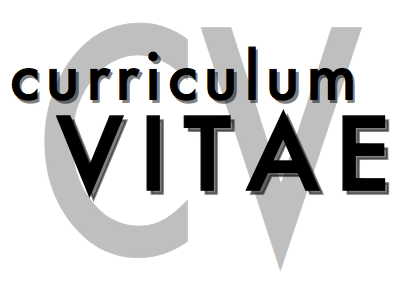
Curriculum Vitae (CV)
A curriculum vitae, vita, or CV, is an overview of your academic experience and accomplishments. According to the OED, loosely translated from Latin, curriculum vitae means “the course of one’s life.”
In the U.S., CVs are used to apply for academic jobs, awards, fellowships, scholarships, and grants. Overseas, the term “CV” is often used synonymously with “resume.”
For more on CVs, please see this CV handout I prepared for a WGSS Career Symposium last year.
![]()
What to do Next…
If you’re trying to follow the notes and assignments in order, I suggest you complete the “Resume Brainstorm” assignment next (it is due at 12pm noon on Saturday, April 11—but you can certainly do it early!).
